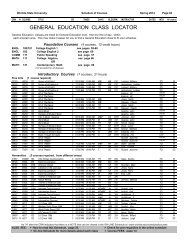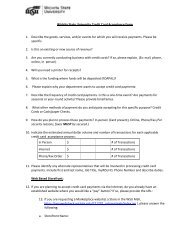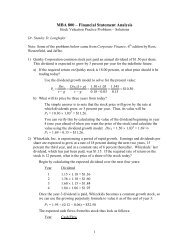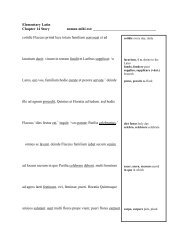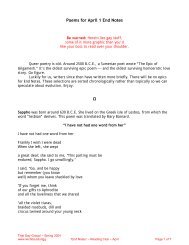Stock Valuation
Stock Valuation
Stock Valuation
Create successful ePaper yourself
Turn your PDF publications into a flip-book with our unique Google optimized e-Paper software.
Integrated Case<br />
9-23<br />
Mutual of Chicago Insurance Company<br />
<strong>Stock</strong> <strong>Valuation</strong><br />
Robert Balik and Carol Kiefer are senior vice presidents of the Mutual of<br />
Chicago Insurance Company. They are codirectors of the company’s pension<br />
fund management division, with Balik having responsibility for fixed-income<br />
securities (primarily bonds) and Kiefer being responsible for equity<br />
investments. A major new client, the California League of Cities, has<br />
requested that Mutual of Chicago present an investment seminar to the<br />
mayors of the represented cities, and Balik and Kiefer, who will make the<br />
actual presentation, have asked you to help them.<br />
To illustrate the common stock valuation process, Balik and Kiefer have<br />
asked you to analyze the Bon Temps Company, an employment agency that<br />
supplies word processor operators and computer programmers to businesses<br />
with temporarily heavy workloads. You are to answer the following questions.<br />
A. Describe briefly the legal rights and privileges of common<br />
stockholders.<br />
Answer: [Show S9-1 and S9-2 here.] The common stockholders are the<br />
owners of a corporation, and as such they have certain rights and<br />
privileges as described below.<br />
1. Ownership implies control. Thus, a firm’s common stockholders<br />
have the right to elect its firm’s directors, who in turn elect the<br />
officers who manage the business.<br />
2. Common stockholders often have the right, called the<br />
preemptive right, to purchase any additional shares sold by the<br />
firm. In some states, the preemptive right is automatically
included in every corporate charter; in others, it is necessary to<br />
insert it specifically into the charter.<br />
B. (1) Write a formula that can be used to value any stock, regardless of<br />
its dividend pattern.<br />
Answer: [Show S9-3 through S9-6 here.] The value of any stock is the<br />
present value of its expected dividend stream:<br />
D1<br />
D2<br />
D 3<br />
D �<br />
Pˆ<br />
0 = � � � � � .<br />
t<br />
3<br />
�<br />
( 1 � r ) ( 1 � r ) ( 1 � r ) ( 1 � r )<br />
s<br />
s<br />
However, some stocks have dividend growth patterns that allow<br />
them to be valued using short-cut formulas.<br />
B. (2) What is a constant growth stock? How are constant growth stocks<br />
valued?<br />
Answer: [Show S9-7 and S9-8 here.] A constant growth stock is one whose<br />
dividends are expected to grow at a constant rate forever.<br />
“Constant growth” means that the best estimate of the future<br />
growth rate is some constant number, not that we really expect<br />
growth to be the same each and every year. Many companies have<br />
dividends that are expected to grow steadily into the foreseeable<br />
future, and such companies are valued as constant growth stocks.<br />
For a constant growth stock:<br />
D1 = D0(1 + g), D2 = D1(1 + g) = D0(1 + g) 2 , and so on.<br />
With this regular dividend pattern, the general stock valuation<br />
model can be simplified to the following very important equation:<br />
Pˆ<br />
0 =<br />
D<br />
r<br />
s<br />
1<br />
�<br />
g<br />
=<br />
D<br />
0<br />
r<br />
s<br />
( 1 �<br />
s<br />
� g<br />
This is the well-known “Gordon,” or “constant-growth” model for<br />
g)<br />
.<br />
s
valuing stocks. Here D1 is the next expected dividend, which is<br />
assumed to be paid 1 year from now, rs is the required rate of<br />
return on the stock, and g is the constant growth rate.<br />
B. (3) What are the implications if a company forecasts a constant g that<br />
exceeds its rs? Will many stocks have expected g > rs in the short<br />
run (that is, for the next few years)? In the long run (that is,<br />
forever)?<br />
Answer: [Show S9-9 here.] The model is derived mathematically, and the<br />
derivation requires that rs > g. If g is greater than rs, the model gives<br />
a negative stock price, which is nonsensical. The model simply<br />
cannot be used unless (1) rs > g, (2) g is expected to be constant,<br />
and (3) g can reasonably be expected to continue indefinitely.<br />
<strong>Stock</strong>s may have periods of supernormal growth, where gs > rs;<br />
however, this growth rate cannot be sustained indefinitely. In the<br />
long-run, g < rs.<br />
C. Assume that Bon Temps has a beta coefficient of 1.2, that the risk-<br />
free rate (the yield on T-bonds) is 7%, and that the required rate of<br />
return on the market is 12%. What is Bon Temps’s required rate of<br />
return?<br />
Answer: [Show S9-10 here.] Here we use the SML to calculate Bon Temps’s<br />
required rate of return:<br />
rs = rRF + (rM – rRF)bBon Temps = 7% + (12% – 7%)(1.2)<br />
= 7% + (5%)(1.2) = 7% + 6% = 13%.<br />
D. Assume that Bon Temps is a constant growth company whose last<br />
dividend (D0, which was paid yesterday) was $2.00 and whose<br />
dividend is expected to grow indefinitely at a 6% rate.
(1) What is the firm’s expected dividend stream over the next 3 years?<br />
Answer: [Show S9-11 here.] Bon Temps is a constant growth stock, and its<br />
dividend is expected to grow at a constant rate of 6% per year.<br />
Expressed as a time line, we have the following setup. Just enter 2<br />
in your calculator; then keep multiplying by 1 + g = 1.06 to get D1,<br />
D2, and D3:<br />
0 1<br />
rs = 13%<br />
| |<br />
g = 6%<br />
D0 = 2.00 2.12<br />
2<br />
|<br />
2.247<br />
3<br />
|<br />
2.382<br />
1.88 � 1/1.13<br />
1.76<br />
� 1/(1.13)<br />
1.65<br />
.<br />
.<br />
.<br />
2<br />
� 1/(1.13) 3<br />
D. (2) What is its current stock price?<br />
Answer: [Show S9-12 here.] We could extend the time line on out forever,<br />
find the value of Bon Temps’s dividends for every year on out into<br />
the future, and then the PV of each dividend discounted at rs =<br />
13%. For example, the PV of D1 is $1.8761; the PV of D2 is<br />
$1.7599; and so forth. Note that the dividend payments increase<br />
with time, but as long as rs > g, the present values decrease with<br />
time. If we extended the graph on out forever and then summed<br />
the PVs of the dividends, we would have the value of the stock.<br />
However, since the stock is growing at a constant rate, its value can<br />
be estimated using the constant growth model:<br />
Pˆ<br />
0 =<br />
D<br />
r<br />
s<br />
1<br />
�<br />
g<br />
=<br />
0.<br />
13<br />
$ 2.<br />
12<br />
�<br />
0.<br />
06<br />
=<br />
$ 2.<br />
12<br />
0.<br />
07<br />
= $30.29.
D. (3) What is the stock’s expected value 1 year from now?<br />
Answer: [Show S9-13 here.] After one year, D1 will have been paid, so the<br />
expected dividend stream will then be D2, D3, D4, and so on. Thus,<br />
the expected value one year from now is $32.10:<br />
Pˆ<br />
1 =<br />
D<br />
r<br />
s<br />
2<br />
�<br />
g<br />
=<br />
$ 2.<br />
247<br />
0.<br />
13<br />
�<br />
0.<br />
06<br />
=<br />
$ 2.<br />
247<br />
0.<br />
07<br />
= $32.10.<br />
D. (4) What are the expected dividend yield, capital gains yield, and total<br />
return during the first year?<br />
Answer: [Show S9-14 here.] The expected dividend yield in any Year N is<br />
Dividend yield =<br />
While the expected capital gains yield is<br />
Capital gains yield =<br />
( Pˆ<br />
N � Pˆ<br />
Pˆ<br />
N�1<br />
D<br />
Pˆ<br />
N<br />
N�1<br />
N�1<br />
)<br />
,<br />
= rs –<br />
Thus, the dividend yield in the first year is 7%, while the capital<br />
gains yield is 6%:<br />
D<br />
P<br />
N<br />
N�1<br />
Total return = 13.0%<br />
Dividend yield = $2.12/$30.29 = 7.0%<br />
Capital gains yield = 6.0%<br />
E. Now assume that the stock is currently selling at $30.29. What is<br />
its expected rate of return?<br />
Answer: The constant growth model can be rearranged to this form:<br />
D<br />
rˆ s = g<br />
P<br />
1 � .<br />
0<br />
.
Here the current price of the stock is known, and we solve for the<br />
expected return. For Bon Temps:<br />
rˆ s = $2.12/$30.29 + 0.060 = 0.070 + 0.060 = 13%.<br />
F. What would the stock price be if its dividends were expected to have<br />
zero growth?<br />
Answer: [Show S9-15 here.] If Bon Temps’s dividends were not expected to<br />
grow at all, then its dividend stream would be a perpetuity.<br />
Perpetuities are valued as shown below:<br />
Pˆ<br />
0 = 15.38<br />
0<br />
|<br />
1<br />
rs = 13%<br />
|<br />
g = 0%<br />
2.00<br />
2<br />
|<br />
2.00<br />
3<br />
|<br />
2.00<br />
1.77<br />
1.57<br />
� 1/(1.13)<br />
1.39<br />
.<br />
.<br />
.<br />
2<br />
� 1/(1.13) 3<br />
� 1/1.13<br />
Pˆ<br />
0 = D/rs = $2.00/0.13 = $15.38.<br />
Note that if a preferred stock is a perpetuity, it may be valued with<br />
this formula.
G. Now assume that Bon Temps is expected to experience nonconstant<br />
growth of 30% for the next 3 years, then return to its long-run<br />
constant growth rate of 6%. What is the stock’s value under these<br />
conditions? What are its expected dividend and capital gains yields<br />
in Year 1? Year 4?<br />
Answer: [Show S9-16 through S9-18 here.] Bon Temps is no longer a<br />
constant growth stock, so the constant growth model is not<br />
applicable. Note, however, that the stock is expected to become a<br />
constant growth stock in 3 years. Thus, it has a nonconstant<br />
growth period followed by constant growth. The easiest way to<br />
value such nonconstant growth stocks is to set the situation up on a<br />
time line as shown below:<br />
0<br />
|<br />
rs = 13%<br />
gs = 30%<br />
1 2 3 4<br />
| | | |<br />
gs = 30% gs = 30% gn = 6%<br />
2.600 3.380 4.394 4.65764<br />
2.301<br />
2.647<br />
� 1/(1.13)<br />
3.045<br />
54.107 = Pˆ<br />
0<br />
4.<br />
65764<br />
Pˆ = 66.54 =<br />
0.<br />
13 � 0.<br />
06<br />
2<br />
� 1/(1.13) 3<br />
� 1/1.13<br />
� 1/(1.13)<br />
46.114 3<br />
3<br />
Simply enter $2 and multiply by (1.30) to get D1 = $2.60; multiply<br />
that result by 1.3 to get D2 = $3.38, and so forth. Then recognize<br />
that after Year 3, Bon Temps becomes a constant growth stock, and<br />
at that point Pˆ<br />
3 can be found using the constant growth model. Pˆ<br />
3<br />
is the present value as of t = 3 of the dividends in Year 4 and<br />
beyond and is also called the terminal value.<br />
With the cash flows for D1, D2, D3, and Pˆ<br />
3 shown on the time<br />
line, we discount each value back to Year 0, and the sum of these<br />
four PVs is the value of the stock today, P0 = $54.107.
The dividend yield in Year 1 is 4.80%, and the capital gains<br />
yield is 8.2%:<br />
Dividend yield =<br />
$ 2.<br />
600<br />
$ 54.<br />
107<br />
= 0.0480 = 4.8%.<br />
Capital gains yield = 13.00% – 4.8% = 8.2%.<br />
During the nonconstant growth period, the dividend yields and<br />
capital gains yields are not constant, and the capital gains yield<br />
does not equal g. However, after Year 3, the stock becomes a<br />
constant growth stock, with g = capital gains yield = 6.0% and<br />
dividend yield = 13.0% – 6.0% = 7.0%.<br />
H. Suppose Bon Temps is expected to experience zero growth during<br />
the first 3 years and then resume its steady-state growth of 6% in<br />
the fourth year. What would be its value then? What would be its<br />
expected dividend and capital gains yields in Year 1? In Year 4?<br />
Answer: [Show S9-19 and S9-20 here.] Now we have this situation:<br />
0<br />
rs = 13%<br />
|<br />
g = 0%<br />
2.00<br />
1<br />
|<br />
g = 0%<br />
2.00<br />
2<br />
|<br />
g = 0%<br />
2.00<br />
3 4<br />
| |<br />
gn = 6%<br />
2.00 2.12<br />
1.77<br />
1.57<br />
� 1/(1.13)<br />
1.39<br />
25.72 = Pˆ<br />
0<br />
2.<br />
12<br />
Pˆ = 30.29 =<br />
0.<br />
07<br />
2<br />
� 1/(1.13) 3<br />
� 1/1.13<br />
� 1/(1.13)<br />
20.99 3<br />
3<br />
During Year 1:<br />
Dividend yield =<br />
$ 2.<br />
00<br />
$ 25.<br />
72<br />
= 0.0778 = 7.78%.<br />
Capital gains yield = 13.00% – 7.78% = 5.22%.<br />
Again, in Year 4 Bon Temps becomes a constant growth stock;
hence g = capital gains yield = 6.0% and dividend yield = 7.0%.<br />
I. Finally, assume that Bon Temps’s earnings and dividends are<br />
expected to decline at a constant rate of 6% per year, that is,<br />
g = -6%. Why would anyone be willing to buy such a stock, and at<br />
what price should it sell? What would be its dividend and capital<br />
gains yields in each year?<br />
Answer: [Show S9-21 and S9-22 here.] The company is earning something<br />
and paying some dividends, so it clearly has a value greater than<br />
zero. That value can be found with the constant growth formula,<br />
but where g is negative:<br />
P 0 =<br />
D1<br />
r � g<br />
=<br />
D 0 ( 1 �<br />
r � g<br />
S<br />
S<br />
g)<br />
Since it is a constant growth stock:<br />
Hence:<br />
As a check:<br />
=<br />
$ 2.<br />
00(<br />
0.<br />
94)<br />
$ 1.<br />
88<br />
=<br />
0.<br />
13 � ( �0.<br />
06)<br />
0.<br />
19<br />
g = Capital gains yield = -6.0%,<br />
Dividend yield = 13.0% – (-6.0%) = 19.0%.<br />
Dividend yield =<br />
$ 1.<br />
88<br />
$ 9.<br />
89<br />
= 0.190 = 19.0%.<br />
= $9.89.<br />
The dividend and capital gains yields are constant over time, but a<br />
high (19.0%) dividend yield is needed to offset the negative capital<br />
gains yield.<br />
J. Suppose Bon Temps embarked on an aggressive expansion that<br />
requires additional capital. Management decided to finance the<br />
expansion by borrowing $40 million and by halting dividend<br />
payments to increase retained earnings. Its WACC is now 10%,<br />
and the projected free cash flows for the next 3 years are -$5<br />
million, $10 million, and $20 million. After Year 3, free cash flow is
projected to grow at a constant 6%. What is Bon Temps’s total<br />
value? If it has 10 million shares of stock and $40 million of debt<br />
and preferred stock combined, what is the price per share?<br />
Answer: [Show S9-23 through S9-28 here.]<br />
0 1<br />
WACC = 10%<br />
| |<br />
-5<br />
2<br />
|<br />
10<br />
3<br />
|<br />
gn = 6%<br />
20<br />
4<br />
|<br />
21.20<br />
-4.545<br />
8.264<br />
� 1/(1.10)<br />
15.026<br />
398.197<br />
416.942 = Total value<br />
21.<br />
20<br />
530 =<br />
0.<br />
10 � 0.<br />
06<br />
2<br />
� 1/(1.10) 3<br />
� 1/(1.10) 3<br />
� 1/1.10<br />
Value of equity = Total value – Debt<br />
= $416.94 – $40 = $376.94 million.<br />
Price per share = $376.94/10 = $37.69.
K. Suppose Bon Temps decided to issue preferred stock that would pay<br />
an annual dividend of $5 and that the issue price was $50 per<br />
share. What would be the stock’s expected return? Would the<br />
expected rate of return be the same if the preferred was a<br />
perpetual issue or if it had a 20-year maturity?<br />
Answer: [Show S9-29 and S9-30 here.]<br />
rˆ p =<br />
D<br />
V<br />
p<br />
p<br />
$ 5<br />
=<br />
$ 50<br />
= 10%.<br />
If the preferred has a 20-year maturity its value would be<br />
calculated as follows:<br />
Enter in your financial calculator: N = 20; I/YR = 10; PMT = 5; FV<br />
= 50; and then solve for PV = $50.<br />
However, to find the value of the perpetual preferred’s dividends<br />
after Year 20 we can enter the following data: N = 20; I/YR = 10;<br />
PMT = 5; FV = 0; and then solve for PV = $42.57. Thus, dividends<br />
in Years 21 to infinity account for $50.00 – $42.57 = $7.43 of the<br />
perpetual preferred’s value.



